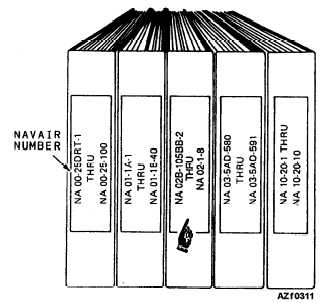You should place each manual and directive that is
received by the library in a binder with a vinyl envelope
spine to accommodate the insertion of an identification
strip (fig. 3-11). This strip is used to identify the manual
or directive contained in the binder. More than one
publication may be placed in the same binder. The
lowest NAVAIR or type directive number should
appear first in the spine window followed by the term
“thru” and ending with the highest manual number or
type directive. After the publications are filed in
binders, the binders are stored on shelves. You should
arrange the binders so the manuals are in alphanumeric
order by NAVAIR publication number (for an airframe
manual, this will automatically result in arrangement
by weapon systems). Letter-type technical directives
for aircraft or airframes should be filed in individual
binders according individual type.
SCREENING AND REVIEW OF
TECHNICAL DATA
All aircraft maintenance organizations are in
continuous receipt of large quantities of technical
information and data. While some of this material is
purely informational, a certain amount requires
immediate or future action. Therefore, it is important
that incoming technical data be screened and reviewed
by technically competent personnel who are in a
position either to advise or to initiate proper action and
disposition of the material. Internal routing procedures
should ensure that designated personnel are made
aware of on-hand, unprocessed technical information
and data.
Figure 3-11.—Identification strip in loose-leaf spine.
TECHNICAL PUBLICATIONS RECEIPT AND
RECORDING
As a technical publication librarian, you must
document receipt of all technical publications and
changes received by the central library. You should
document receipt by using the TPL program and the
TPL stamp. For a change or revision of a technical
publication already held by activity, you should input
the change into the TPL program and use a technical
library stamp (obtained through open purchase) to
identify the publication itself. The TPL stamp must be
used on all publications and changes, including
technical directives, The stamp contains (as a
minimum) the following information: (1) activity, (2)
copy number, and (3) location (QA, P/P, and so forth).
Each basic or revised publication should be stamped on
the title page that identifies the date of the publication.
A technical directive, rapid action change (RAC), or
interim rapid action change (IRAC) should be stamped
on the first page.
If the publication is new, you need to verify its need
by checking with the supervisor, QAR, or work center
where the technical data could be used. If the
publication is not needed, you should perform the
Return Pubs option in the TPL program.
When a publication has been requisitioned, the
basic manual and all of its changes are not always
received at the same time for various reasons. Because
of this you should set aside a location as a hold area for
these manuals. Compare the Hold File and the Order
Log in the TPL program at least monthly to ensure that
the missing manuals and changes are still on order and
to determine their status. You should place a note in the
Tickler File of the TPL program at 30-day intervals as a
reminder to check the Hold File and Order Log.
TRANSACTION FILES
The material maintained in the transaction files
reflects the status of the CTPL. Transaction files consist
of the following:
Most recent ADRL from NATEC
Copies of the last ADRL submission
Copies of completed work center audits
Copies of completed central library audits
Copies of publication requisitions and order logs
A current copy of the Dead File
3-20

